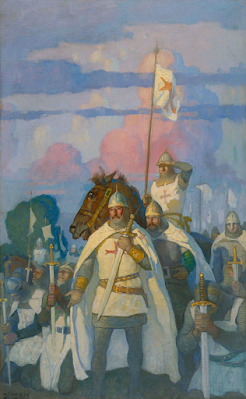The CRUSADES
1096
 |
| "The Crusaders before Jerusalem" by N. C. Wyeth (1924) |
 |
| Crusader crosses cover a wall at the Church of the Holy Sepulchre, Jerusalem (Photo by Rev. Carnehl) |
- 1095 marked the call to crusade from Pope Urban II, and the last military order of crusaders was established and disbanded in 1890.
- Where? Eastern Mediterranean (i.e. the Levant), Baltic shoreline, North Africa, the Iberian Peninsula (i.e. Spain and Portugal), Poland, Hungary, the Balkans (i.e. modern-day Albania, Bosnia, etc.), and within Western Europe (i.e. Italy, France, and Germany)
- Who? Kings, knights, peasants, priests and eventually professional soldiers from Western Europe carried out crusades against Muslims, pagan Wends, Balts, Lithuanians, Mongols, Cathars, Hussites, and other “heretics.”
- What’s the big deal? Today the Crusades are commonly held up as among the worst episodes in Christian history. However, there is so much confusion and mis-information regarding these “penitential war pilgrimages.”
 |
| "The Battle of Dorylaeum" by Gustave Dore (1877) |
Overview of Crusades
- First Crusade (1095 - 1099) captured Jerusalem, “Christ’s Patromony”
- Second Crusade (1147 - 1149) ended in disaster, except for the capture of Lisbon and decisive defeat of the Muslims there in 1147
- The Baltic Crusades (1147 on and off until 1316) was a series of drawn-out campaigns against various groups in the Baltic region
- Third Crusade (1189 - 1192), immortalized by King Richard the Lionheart, captured major Muslim cities, but failed to capture Jerusalem
- Fourth Crusade (1202 - 1204) was a disaster that led to the sack of Constantinople
- Albigensian Crusade (1209 - 1229) was essentially an act of genocide against a sect of Gnostic Christians living in southern France
- Children’s Crusade (1212) was a march to Italy with several thousand French and German youth that were attempting to reach the Holy Land. It ended with the children either starving, returning to their families, or being sold into slavery.
- Fifth Crusade (1217 - 1221) was an attempt to capture Egypt and secure a base for future campaigns. After some initial victories, it ended in severe defeat.
- Sixth Crusade (1228 - 1229) acquired Jerusalem and Bethlehem for the Kingdom of Jerusalem, more through diplomatic maneuvering than warfare.
- Seventh Crusade (1248 - 1254) was another disastrous attempt at taking Egypt as a springboard to further action in the Holy Land.
- Eighth Crusade (1270) was the attempt by Saint Louis (King Louis IX) to seize Tunis.
- Ninth Crusade (1271 - 1272) was a series of successful Crusader raids in the Holy Land led by Edward I (“Longshanks”) of England.
 |
| "Crusaders Capture Jerusalem" from the Description of the Holy Land, 14th century |
1096: The First Crusade
 |
| "The Church of the Holy Sepulchre" by Dean Cornwell (c. 1926) |
Conclusions:
- Crusading was considered an act of love: our idea of “violence” as inherently bad is a modern sensibility. The ancients and medievals had the view that violence was a morally neutral force and could be positively harnessed for protection, liberation, and discipline or negatively used for coercion, destruction, and evil.
- Crusading was considered penitential: the act of crusading was seen as purifying and sanctifying.
- Crusading was exceedingly costly: Most crusaders lost substantial sums of money, not to mention lands and possessions, in “taking up the cross.”
- Crusading was seen as liberation: the goal was the recovery and defense of Christian people and land in the East.
- Crusading was a product of the medieval world view: It’s difficult for us to even remotely understand the crusading fervor of the time. It’s strange to us that so many “mystics” of the Church in the middle ages preached the crusades: Bernard of Clairvaux, Bridget of Sweden, and Catherine of Siena.
 |
| Add caption |
No comments:
Post a Comment